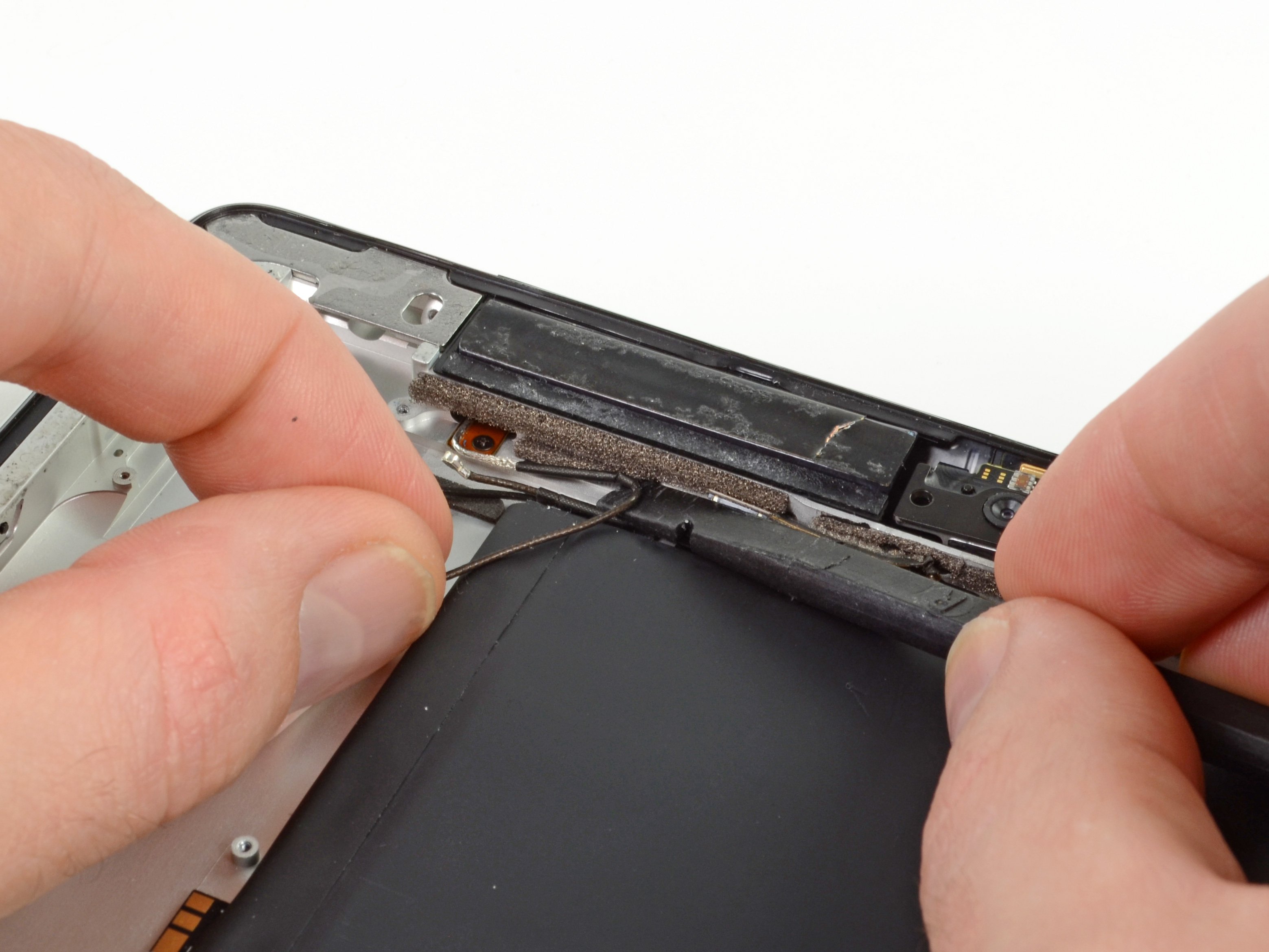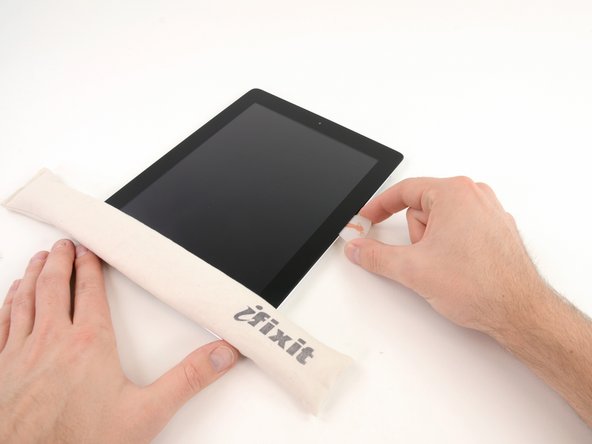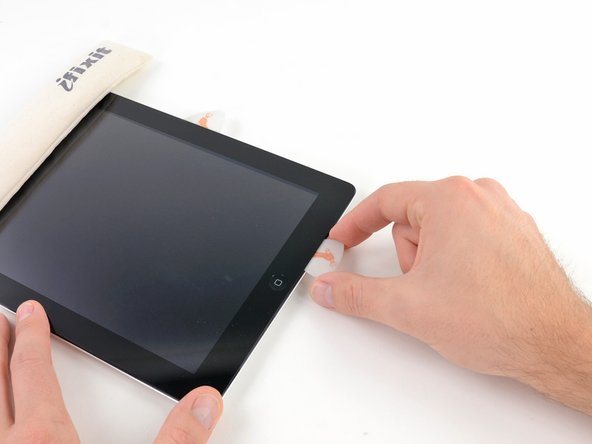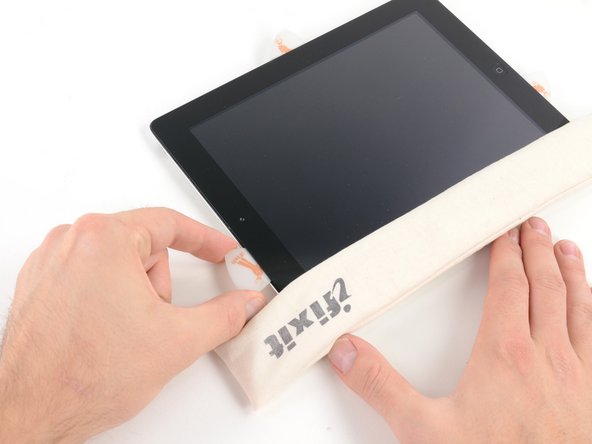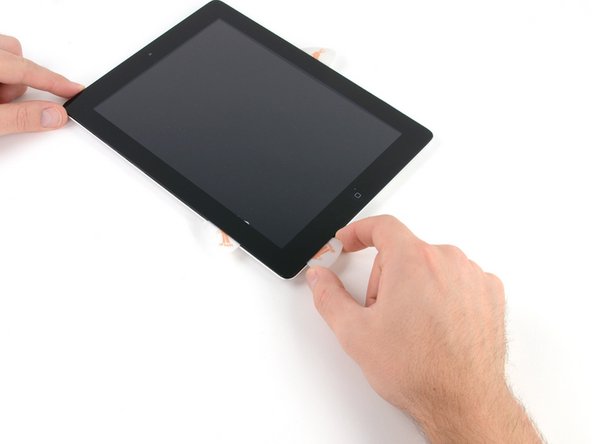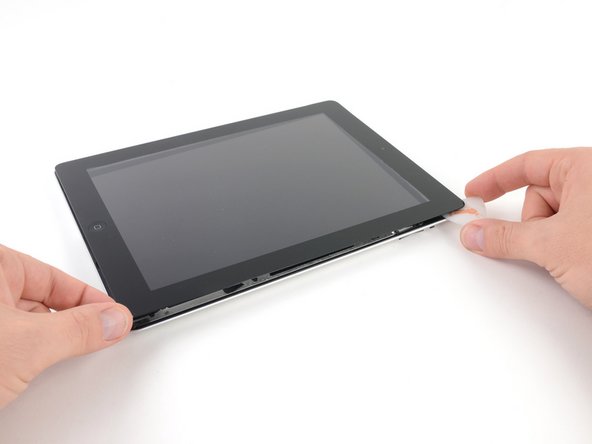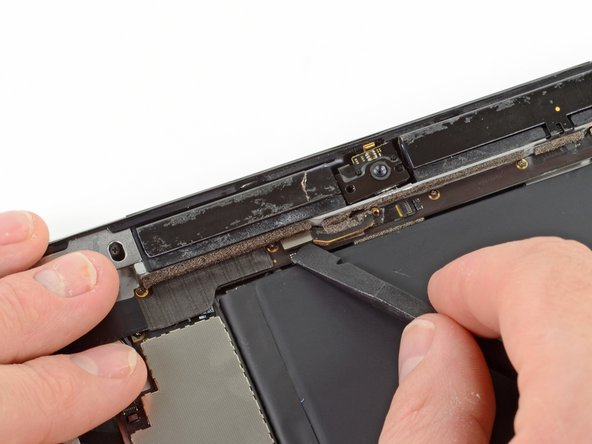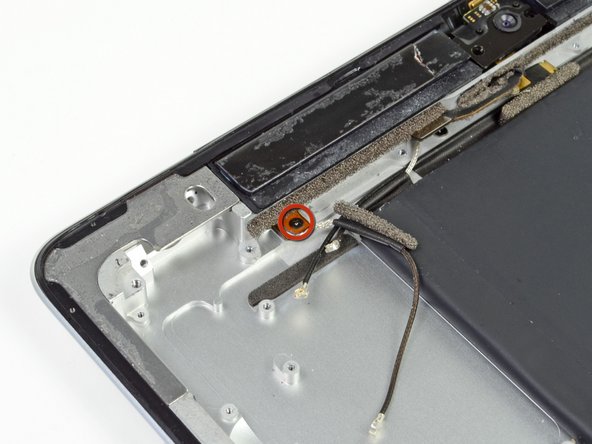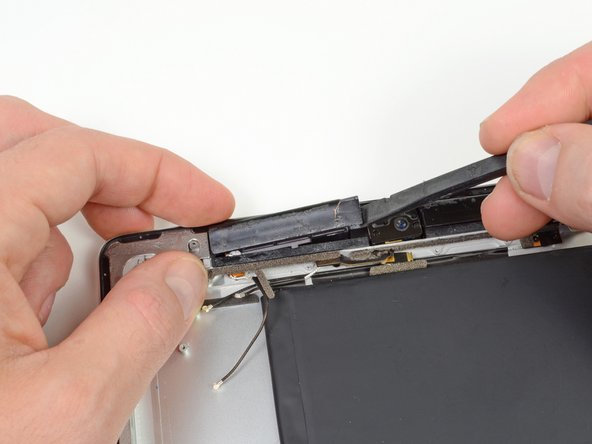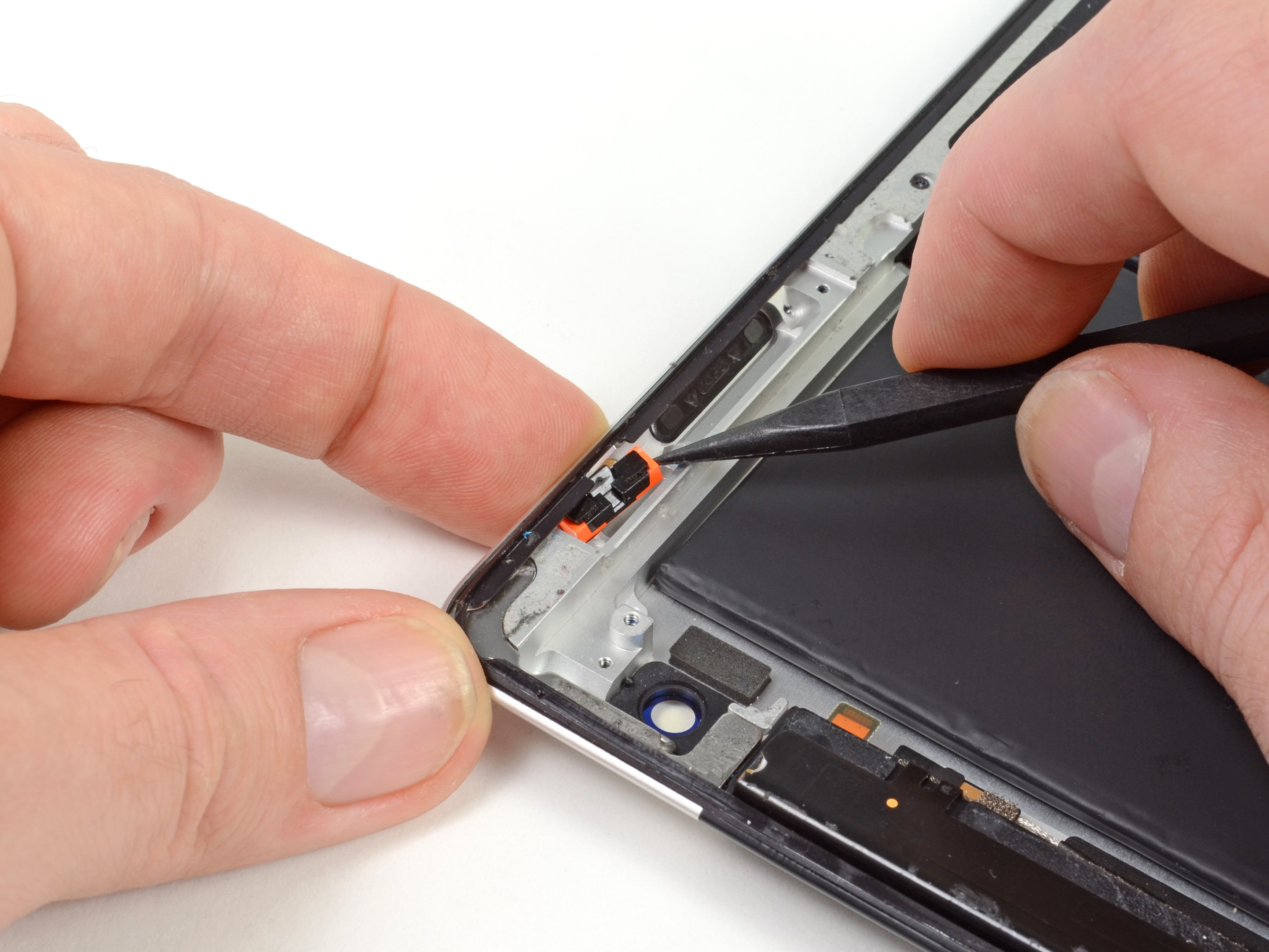iPad 3 4G Left Cellular Data Antenna Replacement
Duration: 45 minutes
Steps: 61 Steps
Ready to give your device a boost by replacing the cellular data antenna? This guide will walk you through the process, step by step. If things get tricky or you just prefer a pro touch, you can always schedule a repair.
Step 1
For carousel microwaves: Make sure the plate spins freely. If your iOpener gets stuck, it may overheat and burn.
We recommend that you clean your microwave before proceeding, as any nasty gunk on the bottom may end up stuck to the iOpener.
- Pop the iOpener right in the middle of the microwave like a champ.
Tools Used
Step 2
Let's keep it cool! Avoid overheating the iOpener during your repair session—too much heat and it could pop! Stick to a maximum of 100˚C (212˚F) for safe handling.
If the iOpener looks like it's puffing up, definitely don't touch it. Just let it cool off and stay safe.
Still too hot in the middle? No worries! Keep using it, but let it chill out a bit longer before reheating. A well-heated iOpener should stay toasty for about 10 minutes.
Depending on how powerful your microwave is, you might need to adjust the heating time a bit. The iOpener is ready to rock when it’s just shy of being too hot to handle.
- Pop that iOpener in the microwave for a quick thirty seconds to get it nice and toasty.
- As you roll through this repair adventure, remember to reheat the iOpener in the microwave for another thirty seconds whenever it starts to cool down. Keep the warmth flowing!
Tools Used
Step 3
Caution: The iOpener is going to be super hot, so handle it with care! Grab an oven mitt if you need to keep those fingers safe.
- Carefully grab the iOpener by one of its two flat ends when taking it out of the microwave—steer clear of that hot middle part!
Tools Used
Step 4
Heads up! The iOpener can get pretty toasty, so make sure to hold it by the end tabs only. Keep those hands safe!
If you're not rocking a microwave, no worries! Just pop your iOpener in some boiling water to warm it up.
- Grab a pot or pan and fill it with enough water to fully cover your iOpener.
- Bring the water to a rolling boil, then switch off the heat.
- Immerse the iOpener completely in the hot water for 2-3 minutes to get it nice and warm.
- Carefully use tongs to lift the iOpener out of the water—watch those fingers!
- Pat the iOpener dry with a towel so it's ready to roll.
- Need to warm it up again? Just boil the water, turn off the heat, and dunk the iOpener for another 2-3 minutes.
Tools Used
Step 5
- Grab a SIM eject tool or simply uncoil a paperclip, and get ready to pop that SIM tray out like a champ!
Step 6
- Gently slide the SIM tray out of its cozy little slot and give it a little pull to free it from the iPad.
- If you're swapping out the SIM card, just pop the old one off the tray and set the new one in its place—like a puzzle piece that fits just right.
Step 7
Pop on some safety glasses to keep those peepers safe, and handle the LCD screen gently to avoid any oops moments.
This will help keep those pesky glass shards in check and maintain the strength of the display while you're prying and lifting it up.
- If your display glass is cracked, keep those shards from going rogue and protect yourself by firmly taping over the glass before you start working.
- Cover the entire iPad screen with overlapping strips of clear packing tape until it’s fully wrapped up like a present.
- Follow the rest of the steps as best as you can. Just a heads-up: once the glass is broken, it might keep cracking as you go, so you may need to carefully use a metal prying tool to lift out the glass pieces.
Step 8
Just a heads up! While you're getting your hands dirty, keep in mind that the glass might not be in one piece. So, throw on some safety glasses to shield your eyes from any sneaky shards that might fly your way.
- Place the iOpener along the right edge of your iPad, pressing it down so it hugs the surface snugly.
- Give it about 90 seconds to work its magic before trying to lift the front panel.
Tools Used
Step 9
It might take a little elbow grease to work that opening tool between the glass and plastic. Take your time, be patient, and wiggle it gently back and forth to make it fit. You'll get there, no rush!
- There's a tiny little gap in the iPad's adhesive ring, hanging out in the upper right corner, about 2.0 inches (~5 cm) from the top of the device. Let's take advantage of this little flaw!
- Position your tool aligned with the mute button. Gently insert the tip of a plastic opening tool into that gap between the front glass and the plastic bezel. Just slide the very tip in there, enough to give that crack a little stretch.
Step 10
- Place the tool carefully between the plastic display bezel and the front panel glass—like finding the perfect spot in a puzzle. This little step is key to getting the job done right.
Step 11
- With the tip of the plastic opening tool snugly nestled between the front glass and the plastic bezel, gently slide a plastic opening pick into that little gap right beside the tool. You've got this!
Step 12
- Gently slide the plastic opening tool out of the iPad, then carefully wiggle the opening pick a bit deeper under the front glass—aim for about half an inch. You've got this!
Step 13
- As you carefully loosen the adhesive on the right side of the iPad, go ahead and warm up the iOpener again, then place it back along the bottom edge to keep things nice and toasty.
Tools Used
Step 14
That adhesive is super strong, so you might need to put in a bit of muscle here! Just take your time and be gentle.
If the opening pick's tip is poking out from beneath the front glass, gently pull it back just a tad. While you won't cause any harm by going this deep, it might leave a bit of adhesive residue on your LCD. Just a heads-up!
- As the iOpener warms up that bottom edge, let's get cracking on releasing that stubborn adhesive from the right edge of your iPad.
- Gently slide the opening pick down the iPad's edge, letting that adhesive loosen up as you go along.
Tools Used
Step 15
If you're releasing the adhesive, you might need to move the heated iOpener back to the right edge of the iPad. Whether or not you need to do this depends on how much time the iPad had to cool while you were working on it. No stress, just keep an eye on it!
- If the opening pick gets a little cozy with the adhesive, just give it a gentle 'roll' along the side of the iPad to keep that adhesive letting go. You're doing great!
Tools Used
Step 16
- Before you pull that first pick out from the bottom corner of the iPad, slip a second pick under the right edge of the front glass. This will keep the sticky stuff from sticking back together.
- Heat up the iOpener again and move it up to the top edge of the iPad.
Tools Used
Step 17
The Wi-Fi antenna is secured to the bottom right edge of the iPad's rear case with screws and a cable. Its position means you’ll want to handle it with care—one wrong move and this little guy might say goodbye for good.
- Heads up, these next steps require a bit of finesse.
- You’ll need to carefully detach the antenna from the front panel. Take it slow, and make sure not to damage the delicate connections at the bottom of the iPad. Keep following the steps closely to avoid any mishaps.
Step 18
Be careful not to slide the pick past the bottom right corner. Going too far could mess with your Wi-Fi antenna. Keep it cool and steady!
- Gently slide the opening pick around the bottom right corner of your iPad. This will help release the adhesive and get you one step closer to fixing your device!
Step 19
As you glide the opening pick along the bottom right edge of the front panel, keep an eye out! The Wi-Fi antenna is snuggled up close to the corner, and if the adhesive gives way the wrong way, it could end up in a sticky situation. Stay sharp and take your time!
Keep the pick tucked just a smidge under the front glass—about 1/8" (3 mm) of the tip should still be hanging out underneath. Don’t yank it all the way out!
- Gently glide the tip of the opening pick along the bottom edge of the iPad to release the adhesive over the Wi-Fi antenna. You’ve got this!
Step 20
- Now that you've gracefully danced past the Wi-Fi antenna (that's about 3 inches or 75 mm from the right edge, right next to the home button), it's time to gently reinsert your trusty opening pick all the way in.
- Give that pick a smooth slide to the right, letting it work its magic to free the adhesive holding the Wi-Fi antenna snug against the front glass.
- Remember, the antenna is cozy down at the bottom of the iPad, secured with screws and a cable. This step is all about making sure the antenna is unhooked from the front panel, so when you lift it off, it stays safe and sound!
Step 21
Keep your iOpener cool, my friend! Heat it for no more than a minute at a time, and let it chill for at least two minutes before giving it another go.
If the adhesive along the bottom edge has cooled down too much, just warm up the iOpener again to get that sticky stuff nice and soft where you’re working.
- Keep sliding the opening pick along the bottom edge of the iPad, carefully pulling it out enough to navigate around the home button. Once you're past it, slide the pick back in about half an inch (10 mm) and keep going!
Tools Used
Step 22
When working on iPad 4 models, slide your pick in no deeper than 1/2 inch (10 mm) here to keep that home button ribbon cable safe and sound.
- Keep sliding that adhesive release tool all along the bottom edge of your iPad like a pro.
- Leave the opening pick chilling under the front glass near the home button to keep things ready for the next move.
Step 23
- Pop the iOpener in the microwave for a quick reheat, then place it on the left edge of the iPad to start loosening up that adhesive. Let the warmth work its magic!
Tools Used
Step 24
If the adhesive has taken a little too long to warm up, just swap the iOpener along the top edge and keep on moving. If your iOpener seems a bit chilly, give it another heat-up!
- Gently slide the opening pick along the top edge of your iPad, easing it out just enough to navigate around the front-facing camera bracket.
- Heads up: the adhesive here is pretty stubborn, so you might need to apply some firm pressure. Take it slow and steady to avoid any slips or accidental damage to yourself or your device.
- If the pick starts to get stuck in the adhesive, try "rolling" it as demonstrated in step 9 to keep things moving smoothly.
Tools Used
Step 25
If the adhesive feels warm and cooperative, go ahead and set the iOpener aside for now. But if it’s still holding on tight, give the iOpener another quick heat-up and place it back on the left edge while you keep at it.
- Keep peeling back the adhesive along the top edge of the iPad, and carefully slide your opening pick around the top left corner like a pro.
Tools Used
Step 26
Hey there! Keep your eyes peeled for the digitizer cable, which is hanging out about 2" (50 mm) from the bottom of the iPad. When you slide that pick, be sure to stop when you're around 2.25" (60 mm) from the bottom—it's like a little treasure hunt, but we don't want to dig too deep!
- Gently slide the opening pick along the left edge of your iPad, carefully releasing the adhesive as you go. The adhesive is thinner here because of the digitizer running along the entire left side. Just make sure to keep the pick no deeper than about 1/2 inch (10 mm) to avoid causing any damage to the digitizer.
Step 27
Heads up! The bottom of the digitizer cable hangs out just about an inch (25 mm) from the bottom of the iPad. Take it slow and steady—no snipping this little guy!
- With the opening pick still tucked under the bottom edge of your iPad, gently lift to free the adhesive from the bottom left corner. You're doing great—keep it steady!
Step 28
Sometimes the adhesive around the edge of the iPad decides to play sticky again. If that happens, gently slide a pick under the spot where the front glass is still holding on and carefully "cut" through the adhesive to free it up.
- Grab one of those trusty opening picks and gently pry up the bottom right corner of the iPad, then snatch it up with your fingers like a pro.
Step 29
Watch out for any sticky bits that might still be hanging on! Grab an opening pick and gently slice through any adhesive that could be keeping that front panel in place. You've got this!
- Grab your iPad by the top and bottom right corners, then give it a gentle twist to lift the front glass away from the device.
- Before putting everything back together, use a microfiber cloth and a blast of compressed air to clean off any dust or fingerprints from the LCD. You want that screen looking fresh before you seal it up again!
Step 30
- Let's get those four 2 mm Phillips #00 screws outta there that are holding the LCD snug against the aluminum frame. You've got this!
Step 31
Handle the LCD with care! The ribbon cable is delicate and can snap if bent too much. Keep it smooth and gentle.
- Grab your plastic opening tool or spudger and gently pry up the right edge of the LCD from the iPad.
- Then, swing the LCD around its left side and let it rest on top of the front panel like a well-behaved flap.
Tools Used
Step 32
- Gently slide the tip of your spudger under the tape covering the LCD ribbon cable connector and lift it off. Easy does it, you're on the right track!
Tools Used
Step 33
- Lift up the flap on the LCD ribbon cable's ZIF connector with care.
- Gently wiggle the LCD ribbon cable free from its socket on the logic board. Tweezers or your fingers should do the trick!
- If the LCD screen isn't turning on after you've reconnected the ZIF connector, don't panic. You might need to force restart your iPad. Just hold down the power and home buttons for about 10 seconds until the Apple logo appears. It should be good to go!
Step 34
- Gently lift the LCD off the front panel without touching the screen. Give it a little nudge and let it pop off with ease.
Step 35
- Grab the spudger and gently work the tip under the tape that’s holding down the touchscreen ribbon cable to the logic board. A little wiggle and it should peel right off!
Tools Used
Step 36
- Gently lift the flap on both of the touchscreen ribbon cable ZIF connectors. This will give you the access you need to move forward.
Step 37
- Grab that trusty spudger and gently slide the flat end underneath the digitizer ribbon cable to loosen up the adhesive. It's like giving it a little nudge to say, 'Hey, time to come off!'
- Now, with a steady hand, pull the digitizer ribbon cable straight out of its cozy sockets on the logic board. You got this—it’s all about that smooth and steady motion!
Tools Used
Step 38
- Gently lift the touchscreen ribbon cable and slide the flat end of a spudger under it to carefully loosen the adhesive holding it to the back aluminum case.
Tools Used
Step 39
- With a gentle tug from your fingers, coax the touchscreen ribbon cable out of its snug spot in the aluminum frame. You've got this!
- Now, go ahead and carefully lift the front panel off the iPad. Just think of it as giving your device a little spa day!
Step 40
- Gently peel off that piece of electrical tape that’s keeping the headphone jack cable connector under wraps. It's like unwrapping a gift, but way less exciting.
- Take your spudger and carefully lift up the retaining flaps on both of the ZIF connectors holding the headphone jack cable in place on the logic board. A little lift, and you’re all set.
Tools Used
Step 41
- Gently slide the flat end of your spudger under the headphone jack assembly cable to loosen the sticky adhesive holding it to the rear aluminum frame.
- Carefully pull the headphone jack assembly cable straight out from its socket on the logic board.
Tools Used
Step 42
- Gently peel back and remove the tape that's holding down the SIM board cable ZIF connector.
- Flip up the little retaining flap on the SIM board cable ZIF connector—like opening a tiny door.
- Carefully use a spudger tip to pull the SIM board cable straight out from its socket on the logic board.
Tools Used
Step 43
- Unscrew the three 1.75 mm Phillips #00 screws holding the SIM board to the aluminum frame—steady hands, you've got this!
Step 44
As you gently move the headphone jack assembly cable out of the way, be sure to avoid tugging too hard on the headphone jack—it's a delicate piece, and you don't want to risk pulling it off. Take it easy, and you'll be golden!
- Gently keep the headphone jack assembly cable out of the way, then carefully lift the SIM board off the iPad.
Step 45
- Carefully lift and peel away the adhesive tape that’s holding down the headphone jack assembly.
Step 46
- Carefully take out the single 2.6 mm Phillips #0 screw that’s holding the camera cable snugly to the headphone jack assembly. You've got this!
Step 47
- Grab your spudger and use the flat end to gently nudge the front-facing camera out of its socket on the headphone jack assembly. Nice and easy, like you’re lifting a tiny treasure!
- Keep the spudger in place, but slide it to the right to loosen the adhesive that's holding the camera cable down. It should release without too much fuss.
Tools Used
Step 48
- Gently use the spudger tip to lift up the little retaining flap on the microphone cable's ZIF connector—think of it like opening a tiny door.
- Slide the spudger tip under the microphone ribbon cable and carefully lift it out from its ZIF connector.
- Move the spudger to the left to loosen the adhesive that’s sticking the microphone ribbon cable to the headphone jack assembly.
Tools Used
Step 49
- Grab your trusty spudger and gently slide the flat end underneath the antenna connector cable. Give it a little lift to pop it out of its cozy socket on the headphone jack assembly board. You've got this!
Tools Used
Step 50
- Gently flip up the little flap that holds the volume and power button ribbon cable connector in place on the headphone jack assembly board.
- Carefully slide the volume button ribbon cable out of its ZIF connector.
Step 51
These screws are nestled cozily into the aluminum frame. Make sure to line up your screwdriver with the screw for a smooth twist—this will help you avoid stripping it like a pro!
- Time to unscrew these little guys holding the headphone jack assembly in place:
- Five 2.6 mm Phillips #0 screws
- Two 2.2 mm Wide Head Phillips #00 screws
- Two 2.6 mm Phillips #00 screws
Step 52
- Gently grip the ribbon cable of the headphone jack assembly and carefully slide the assembly down, keeping it parallel to the iPad as you guide it toward the bottom of the device.
Step 53
- Take a firm grip on the headphone jack assembly with both hands, and gently pull it away from the iPad. Just be mindful of any cables that might want to get caught in the action!
Step 54
If you see any pieces of electrical tape hanging out, go ahead and peel them off the Wi-Fi antenna, speaker cable, and dock connector cable. You've got this!
Step 55
Remember to gently pry under the connector, not the socket itself! Going for the socket can lead to some serious damage, and we definitely want to avoid that!
- Gently unplug these connectors from their spots on the logic board:
- Wi-Fi antenna cable
- Speaker connector cable.
- Dock connector cable.
Step 56
- Time to get those screws out! Remove the seven screws holding the logic board in place against the rear aluminum panel.
- Six 2.1mm Phillips #00 screws should be removed first.
- Now, grab your 2.5mm Phillips #00 to unscrew that last one. Almost there!
Step 57
- Gently flip the logic board over, being careful not to snag any cables.
- Take your trusty spudger and delicately detach the three antenna connectors from their snug spots on the logic board.
Tools Used
Step 58
- Gently use the flat end of a spudger to pop loose the adhesive tape that’s keeping the cellular data antenna cable stuck to the aluminum frame.
Tools Used
Step 59
- Time to get cozy with your tools! Grab that trusty Phillips #00 screwdriver and remove the lone 1.75 mm screw holding the cellular data antenna cable to the aluminum frame. You're almost there!
Step 60
- Carefully coax the cellular data antenna out of its cozy spot in the iPad. A spudger can come in handy if you need a little extra help.
Tools Used
Step 61
Make sure the cellular data antenna cable slides through its hole while staying chill and parallel to the aluminum frame. Forcing it through is a no-go and could mess things up.
- To put your device back together, just follow these steps in reverse. You've got this! And if you hit a snag, remember, we're here to help—feel free to schedule a repair.
